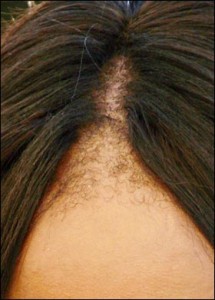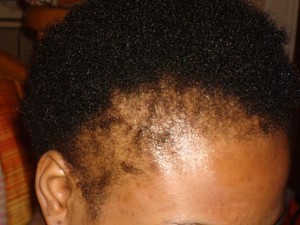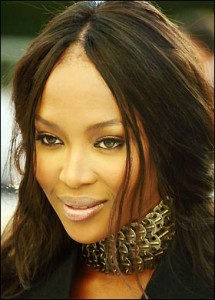Style
Dealing with Traction Alopecia
By Azara – Bella Naija Beauty & Wellness Editor
As a little girl I remember getting my hair done by this lady whose hair line was basically non existent. I remember being repulsed by it and thinking that it was very stupid for her to braid the rest of her hair, as if people would be looking at her nicely styled braids instead of her nonexistent hairline. However, I never thought that in a million years I would be weaving my hair to cover my disappearing hairline.
As I slowly take off my hair weave, being careful not to look in the mirror to see what my hair has become, I think to myself; how did I get to this point? How did my beautiful hair become a thing of shape, immediately thoughts of miniature braids, self-relaxed hair and sticky situations with hair glue come to mind. I finally look in the mirror and realize that no one is to be blamed of my situation but myself.
A year ago, I noticed that my front edges had not grown in a while, after using several products and visiting several hair stylists; I finally decided to take the big step and visit a dermatologist and to my dismay I got the
news that I was dreading. The dermatologist told me that I had a type of hair loss known as Traction alopecia. At the sound of the word “Alopecia”, I was immediately overcome with the images of bald women, and cried, the dermatologist tried his best to comfort me by telling me that this hair disease is very common African American woman but I was overcome with embarrassment that I left without asking him any question.
As soon as I got home, I decided to do more research on this hair problem, as well as take steps towards restoring my hair again. I decided that if I got myself into this situation, I would find a way to get myself out, and thanks to Traction Alopecia, I found my new passion: Hair.
So what exactly is Traction Alopecia? it is a hair loss condition caused by damage to the hair follicle and dermal papilla due to constant pulling and tension over a long period of time. The pulling and tension is usually created by tight braids, pony tails and over processed hair, and with time the tension caused by these hairstyles result in a lack of blood circulation in those areas that cause irreversible and permanent hair loss.
While conducting my research on this condition, I was surprised to find out how many women this affects, I remembered all the ladies in the hair salon that seem to only have hair in the middle, I remembered a friend of mine that never pulled her hair back but always divided in the middle, and most importantly I thought of myself. I thought of the times when I had braids so tight but I never complained because I believed that “beauty was pain”, I remembered actually wanting and expecting my braids and weaves to hurt because then that meant that my hair was still “new”. I remembered when I would let the relaxer stay longer than it should, just so that my hair would finally be silky, and most importantly, I remembered the time when I did my “Agbani Darego ponytail” and drowned my hair with gel. I thought of all the years of abuse and stress I put my hair through, and how I am now suffering because of it. If only I had known.
Although there are temporary solutions like Lace Wigs and Lace frontals that work to hide the problem, Traction Alopecia as of the current moment has no solution other than hair transplants for those with severe situations. However, it is important for women to be educated in the health of their hair in order to avoid developing this situation later on in life. There are several ways to avoid developing Traction Alopecia and they include: minimizing the use of Strong relaxers, loosening up tight braids and weaves, and avoiding tight ponytails. It is also important to remember that your hair needs a break period from hair activities; after you take out a weave or braid, wait a week before you relax your hair and an additional week before you braid it again. It is also important to condition one’s hair at least once a month, to ensure that it is stronger and healthier.
Although Traction Alopecia affects a lot of women, there are still women with great genetics whom are rarely affected with problems like this, but for those of us that are, it is very important for us to be careful about the things we do to our hair. Very often women try to copy each other’s hairstyles and pay little attention to the stress that such hairstyles create for their scalp. We must learn to understand our hair and scalp sensitivity before we venture out to do something that we are not used to.
In my quest to treat my hair, I decided to cut it off and start afresh and I have used nothing but natural products to moisturize and condition my hair. It’s been several months since my hair cut, and I’ve noticed some changes. Even though things are not back to normal (the dermatologist said it would take time), I am happy with the fact that now, I am more aware of my hair. I still wear my weaves and braids, but this time I am more conscious of my hair health instead of my hairstyles, this time I am no longer shy about telling the hairstylist how loose or big I want my braids to be. But the most important thing I learned from my premature hair loss, was my passion to inform other women about hair.
If you think that you have or might be suffering with traction alopecia, be sure to see a hair stylist and a dermatologist. For more information on keeping and maintaining a healthy hair and hairstyle, be sure to check out my blog: http://hairbyazara.blogspot.com
Here are the Summary Points of Traction Alopecia from the informational website Traction-Alopecia.com:
· In the USA, traction alopecia is most common in African-American women due to their hair styles. Can also occur in men who use hair weaving to conceal bald areas.
· More common in children and young adults and less common in older adults.
· Traction Alopecia is reversible if detected early but can lead to permanent hair loss. Early detection is the key.
· For women, no medical treatment exists and hair grafts are their only option.
· Traction alopecia is more common in the frontal and temporal regions, but also depends on the hair style. With cornrows, hair loss is adjacent to the rows.
· Women and men who suspect they might be vulnerable to traction alopecia should change their hair style and/or reduce usage of hair chemicals, and consult their dermatologists.




























